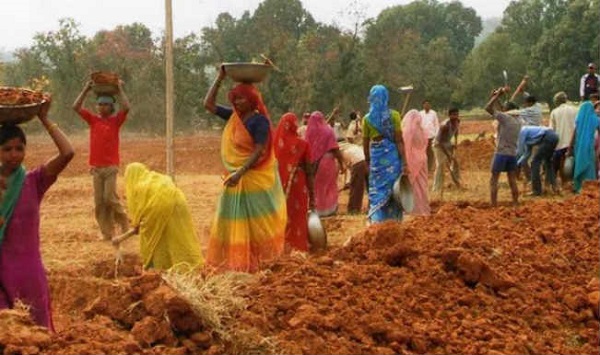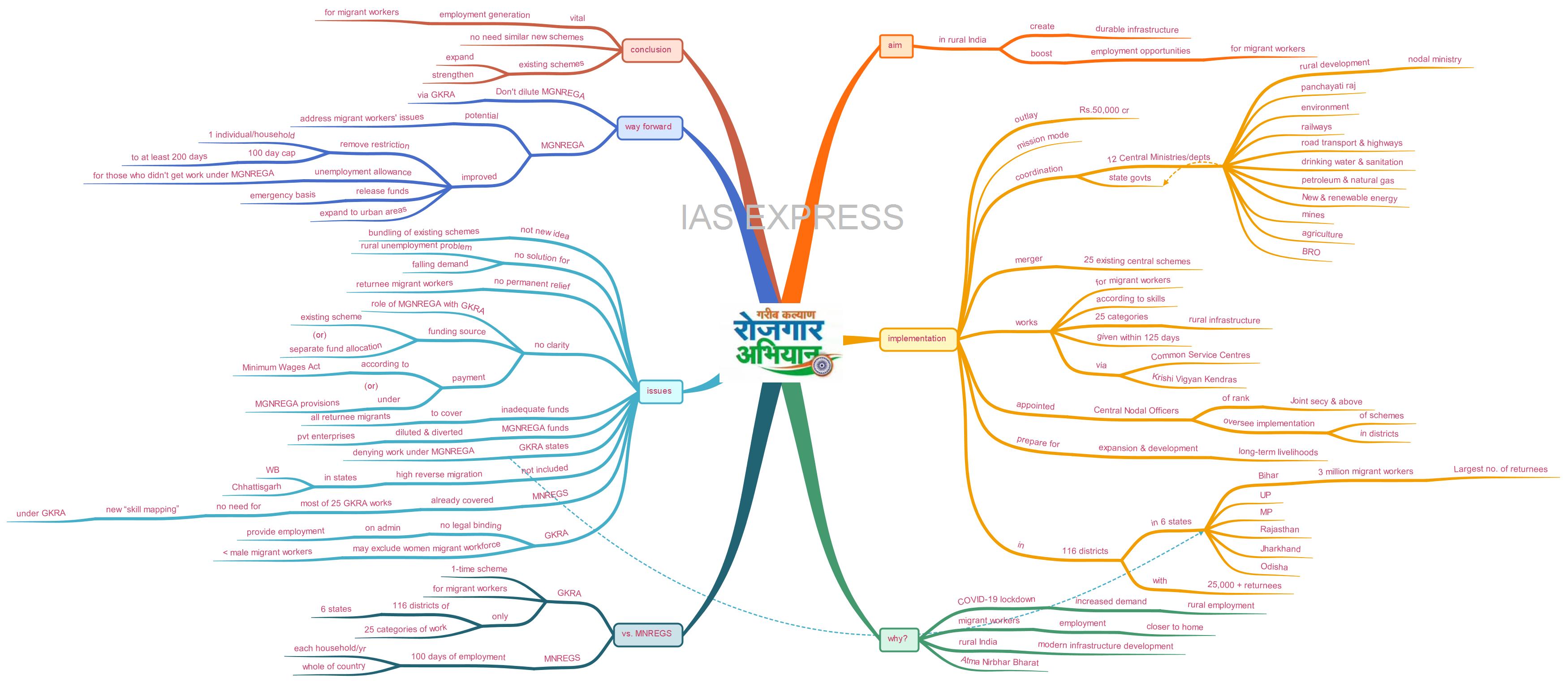Garib Kalyan Rojgar Abhiyaan – Issues and Way Ahead

The mass exodus of migrant workers to their native villages following the temporary closing down of industries in urban areas to curb the COVID-19 outbreak has increased the demand for employment in Rural India. This situation creates a new opportunity to improve the rural economy by employing such population in infrastructure development and other vital government projects like waste management and improving access to water in rural India. To utilise this opportunity, the government had launched Gram Kalyan Rojgar Abhiyaan in select states. However, the new initiative has diluted the role of MGNREGS, another similar but comprehensive rural employment generation scheme.
What is Garib Kalyan Rojgar Abhiyaan?
- The Centre has launched Garib Kalyan Rojgar Abhiyaan on June 20 this year to boost livelihood opportunities and create durable infrastructure in rural India.
- The main objective is to generate employment opportunities in rural India for migrant workers who have returned to their villages amid the COVID-19 outbreak and nationwide lockdown.
How is the scheme being implemented?
- The scheme, with an outlay of Rs.50,000 crore, is applicable for the migrant labourers who have returned to their home states during the coronavirus lockdown.
- Twelve central ministries/departments are coordinating to implement this scheme.
- These include rural development, Panchayati Raj, road transport and highways, mines, drinking water and sanitation, environment, railways, petroleum and natural gas, new and renewable energy, telecom, border roads and agriculture.
- The Ministry of Rural Development is the nodal ministry for this initiative.
- These ministries/departments will closely coordinate with the state governments.
- The Central Nodal Officers of the rank of Joint Secretary and above are appointed to oversee the effective implementation of various schemes in the selected districts.
- Centre’s 25 existing schemes are merged under this new initiative. These include Pradhan Mantri Awas Yojana, Gram Sadak Yojana, Jal Jeevan Yojana among others.
- The scheme will work in mission mode, involving the focused implementation of 25 categories of works in 116 districts across the country.
- The 25 categories of work under this scheme will meet the needs of the villages like rural housing for poor, plantations, provision of drinking water through Jal Jeevan mission, Panchayat Bhavans, community toilets, solid and liquid waste management works, rural mandis, rural roads and other infrastructure like cattle sheds, Anganwadi Bhavans, etc.
- The works will be given within 125 days of the launch of the scheme according to the skills of the labourers.
- The tasks for the labourers will be provided through Common Service Centres and Krishi Vigyan Kendras.
- The program will also prepare for the expansion and development of long-term livelihoods.
Why only six states are chosen?
- The scheme is implemented in villages across 116 districts in 6 states.
- These 116 districts have received at least 25,000 migrant workers each.
- The six states are Bihar, Uttar Pradesh, Madhya Pradesh, Rajasthan, Jharkhand and Odisha.
- The largest number of returnee migrant workers (3 million) is in Bihar.
Why do we need this scheme?
- The nationwide lockdown to curb the COVID-19 outbreak has led to the temporary shutting down of the industries, leaving many migrant workers from villages in cities with no jobs.
- This led to migrant workers returning to their native villages during the lockdown period, leading to a surge in the demand for rural employment.
- Garib Kalyan Rojgar Abhiyaan seeks to provide employment for these workers closer to home.
- The scheme also provides for modern infrastructure development in rural areas, including access to the internet.
- It is also said to play a major role in achieving Atma Nirbhar Bharat (Self-Reliant India).
How is the scheme different from MGNREGS?
- Garib Kalyan Rojgar Abhiyaan is different from Mahatma Gandhi National Rural Employment Guarantee Scheme (MGNREGS).
- MGNREGS ensures 100 days of employment for each household in a year and is implemented across the country. The scheme encompasses a wide array of works and the wages will be provided by the government.
- In contrast, Garib Kalyan Rojgar Abhiyaan Yojana is a one-time scheme for employing migrant workers who have returned to their home villages during the lockdown.
- The scheme applies to only 116 districts in 6 states and provides only 25 categories of work.
What is the issue with this scheme?
- The Garib Kalyan Rojgar Abhiyaan is not a new idea.
- It is just 25 existing schemes being bundled together in the name of providing jobs for migrant workers.
- These 25 schemes are already being implemented in rural India under 12 different ministries. The new scheme just brings them together on one platform.
- The new scheme does not offer any solution to the rural unemployment problem.
- It also does not provide any permanent relief for the returnee migrant workers.
- The scheme does not address the issue of demand generation during the pandemic crisis.
- There is no clarity regarding the role of MGNREGA alongside this scheme.
- It is not clear whether the funding for this scheme will come from the existing schemes or from a separate fund allocation.
- Furthermore, the scheme’s funding is inadequate when compared to the number of returnee migrant workers.
- Conservative figures estimate the number of migrant workers to be around 8 million. The funding allocation will only provide Rs.56.81 per migrant worker.
- The government is also not clarifying whether these skilled workers will be paid as per the Minimum Wages Act or the wages paid under the MGNREGA provisions.
- Additionally, the MGNREGA funds are also being diluted and diverted to private enterprises to subsidise their wage payment, making it difficult for the authorities to provide wages for the workers through any of these schemes.
- It is found that the states identified for Garib Kalyan Rojgar Yojana Abhiyaan are those that are denying work under MGNREGA.
- Bihar received more than half of the Rs.4,764 crore spent between June 20 and June 28. The state is known for its poor implementation of the MGNREGA.
- States of West Bengal and Chhattisgarh are not included under this scheme though the reverse migration in these states is particularly high.
- MGNREGS already covered most of the 25 kinds of work mentioned in the Garib Kalyan Rojgar Yojana. There is no need for a new “skill mapping” under the new scheme.
- While the MGNREGA makes getting employment under it a legal right, the new scheme does not have any such legal binding on the government.
- Garib Kalyan Rojgar Yojana is meant for migrant workers in those districts where their numbers are 25,000 or more. This creates a possibility of exclusion of women migrant workers who are relatively lesser in number.
- However, there is a high demand for employment from the women workforce in these districts. On the other hand, the MGNREGA provides relief for them.
What can be the way forward?
- MGNREGA should not be diluted in the name of Garib Kalyan Rojgar Abhiyaan as its potential to provide relief for the migrant workers is especially high in the current crisis caused by the nationwide lockdown.
- MGNREGA must be used to its full capacity by removing the restriction of only one individual per household to make every individual in the household eligible.
- The cap of 100 days should be expanded to at least 200 days.
- The unemployment allowance should be guaranteed for all those who failed to get work under the MGNREGA.
- The Centre can release funds on an emergency basis.
- Instead of creating a new scheme, MGNREGA can be strengthened and expanded to the urban areas for expediting infrastructure and other priority projects.
Conclusion:
Employing migrant workers is vital as they are facing the brunt of the nationwide lockdown and economic standstill. The dilution of the fund for the existing schemes by distributing it to new but similar schemes is a waste of limited resources. During the current crisis, it is necessary to enhance and strengthen the existing government welfare schemes by removing bottlenecks and broadening the criteria to make full use of limited resources.
Practice question for mains:
Is Garib Kalyan Rojgar Yojana simply a diluted version of MGNREGS? Elucidate. (250 words)
If you like this post, please share your feedback in the comments section below so that we will upload more posts like this.


